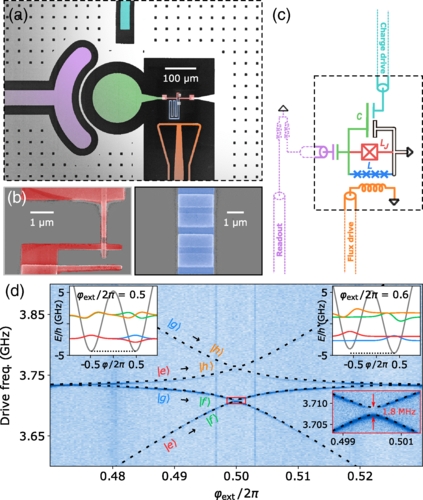Researchers from Laboratoire Kastler Brossel, Alice & Bob, Laboratoire de Physique de l’Ecole normale supérieure, and Quantronics group have successfully designed and operated a heavy fluxonium qubit with a low transition frequency of 18 MHz. Unlike most qubits limited to the GHz frequency range, this fluxonium qubit can be biased to a very low frequency, making it highly sensitive to a radiofrequency field. The team demonstrated its charge sensitivity, which rivals advanced transport-based devices, and its potential for exploring quantum phenomena in the 1-10 MHz range. This development opens up new possibilities for coupling with other devices operating in the MHz range.
Introduction to Fluxonium Qubits
Fluxonium qubits are superconducting qubits with remarkable success in hybrid quantum circuits due to their strong dipole moment and long coherence times. However, most qubit architectures are limited to the GHz frequency range, which severely constrains the systems they can interact with. The fluxonium qubit, on the other hand, can be biased to very low frequency while being manipulated and read out with standard microwave techniques.
The Heavy Fluxonium Qubit
A team of researchers from Laboratoire Kastler Brossel, Alice & Bob, Laboratoire de Physique de l’Ecole normale supérieure, and Quantronics group have designed and operated a heavy fluxonium with an unprecedentedly low transition frequency of 18 MHz. They demonstrated resolved sideband cooling of the hot qubit transition with a final ground state population of 97.7%, corresponding to an effective temperature of 23μK. They also demonstrated coherent manipulation with coherence times T1=34 μs, T2=39 μs, and single-shot readout of the qubit state.
The researchers showcased the fluxonium qubit’s high sensitivity to a radiofrequency field by directly addressing the qubit transition with a capacitively coupled waveguide. Through cyclic qubit preparation and interrogation, they transformed this low-frequency fluxonium qubit into a frequency-resolved charge sensor. This method resulted in a charge sensitivity of 33μ Hzp or an energy sensitivity in joules per hertz of 28ℏT.
The charge sensitivity of the fluxonium qubit rivals that of the most advanced transport-based devices while maintaining inherent insensitivity to DC charge noise. The capacitance of the fluxonium electrode demonstrated in this work exceeds the typical gate capacitance of single-electron transistors (SETs) by approximately two orders of magnitude, resulting in a record-low energy sensitivity.
Potential Applications
The high charge sensitivity combined with the large capacitive shunt of the fluxonium qubit unlocks new avenues for exploring quantum phenomena in the 1-10 MHz range, such as the strong coupling regime with a resonant macroscopic mechanical resonator. The demonstrated charge sensitivity combined with large gate capacitance are well suited to exploring quantum phenomena with low-frequency mechanical systems.
Circuit Design of the Fluxonium Qubit
The heavy fluxonium circuit comprises a small Josephson junction energy shunted by a large capacitance to ground capacitive energy and a superinductance inductive energy formed by 360 large Josephson junctions in series. Hamiltonian writes that the junction chain behaves as a linear inductor and the circuit.
The article titled “High-Sensitivity ac-Charge Detection with a MHz-Frequency Fluxonium Qubit” was published in the Physical Review X on January 24, 2024. The authors of the article include Baldo-Luis Najera-Santos, Rémi Rousseau, Kyrylo Gerashchenko, Himanshu Patange, Alberto Riva, Marius Villiers, T. Briant, P.-F. Cohadon, A. Heidmann, José M. Palomo, Michaël Rosticher, H. le Sueur, Alain Sarlette, W. Clarke Smith, Zaki Leghtas, Emmanuel Flurin, T. Jacqmin, and S. Deléglise. The article discusses the high-sensitivity ac-charge detection with a MHz-frequency fluxonium qubit.

